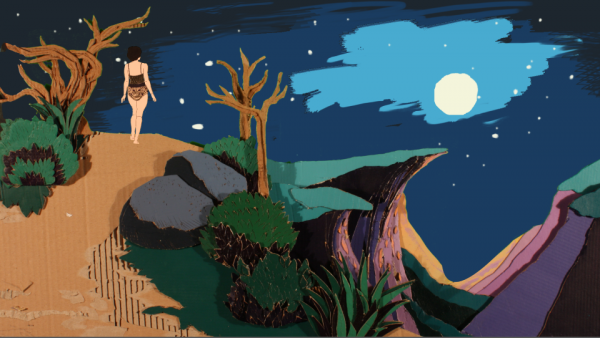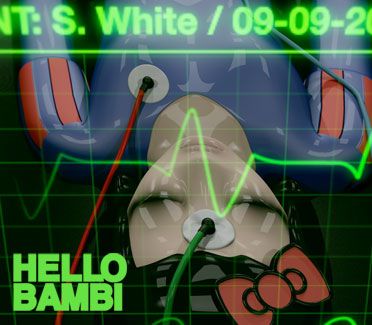A post-apocalyptic war torn neo-Tokyo, Greek statues come to chorus girl dancing life, a psychedelic Snow White with a sprinkling of Bambi fetishism and some hard-core erotic and amusing (are the two ever mutually exclusive?) Spanish shorts.
This past week, the Regent Showcase hosted the 3rd Annual Los Angeles Animation Film Festival. The four-day fest boasted 35mm screenings of The Iron Giant, Fantastic Planet, Gulliver’s Travels, Team America, Grave of the Fireflies and honoree Bill Plympton’s The Tune, amongst many others. For a full rundown of just what screened and when, might I direct you to the festival’s website. For the day one highlights – which included a screening of Akira and a bunch of X-rated shorts, hit the jump.
Awakening
The accompanying in-competition short to Akira, Amy Lee Ketchum’s delightful paper animation depicts a lone woman’s transcendence (evolution?) from her physical form. The lofty, some might say obtuse premise, is grounded by a surprising sense of humor and sweetness, as the lone woman finds herself caught up in a Dionysian-like dance ritual. Statues come to life forming a chorus line of beckoning dancers inviting the heroine to join in, intermingle, become one of them. At first glance, Awakening might seem an odd companion piece to the relentlessly grim and nihilistic Akira – but both films are deeply concerned with the transcendence of man; Akira presenting the apocalyptic be-careful-what-you-wish-for version, opposed to Awakening’s good-natured idealism. Flip sides of the same coin. A clip to Ketchum’s Awakening can be found here, amongst more of her work.
Akira (spoilers within)
Shamefully, I had never seen Katsuhiro Otomo’s Akira before the fest’s screening. Heard much about it. Read snippets of the manga. Been recommended to watch. Forewarned to its nihilism. But Good Golly – I was not prepared for just how relentlessly downbeat Akira truly is. Many have labeled Akira as an anime sci-fi Shakespearean tragedy, but that description doesn’t do the film justice. For Akira has much more in common to the epic Greek tragedies than to Shakespeare’s.
Shakespearean tragedies hinge on simple misunderstandings – a tardy messenger, a dropped handkerchief, a misinterpreted exchange. The inherent tragedy is that the morbid outcome could easily have been avoided, if only Romeo waited just a second or Othello talked to Desdemona or Lear (again) talked to Cordelia. The characters have choices – they just make the ‘wrong’ ones.
In a Greek tragedy, everyone’s fucked. Regardless of whatever choice he/she makes. Oedipus and Antigone are doomed from minute one – quite literally at birth. Any choice thereafter only leads to disaster. The tragedy of Akira is similarly unavoidable – only it’s not a person’s fate but the city of Tokyo itself. Akira depicts the somber fall of a civilization.
The film opens as a nuclear bomb tears through Tokyo, bringing about World War III. Cut to thirty-one years later and Tokyo has been reborn as a grunge-punk nightmare: the streets run by biker gangs, the government rendered completely ineffective, the military chomping at the bit to stage a coup… When psychic withered child Kiyoko prophesizes Tokyo will fall once more, it’s not a warning but an inevitability. Tokyo will be destroyed. Millions will die. It’s only a matter of time.
That the film ends exactly as promised shouldn’t be surprising. But the manner in which Katsuhiro depicts the outcome is. Instead of wallowing in the destruction of Tokyo, the film intercuts buildings being destroyed/characters crushed with the childhood memory of lead tragic-hubris figure Tetsuo: he as a child meeting best friend Kaneda, a simple moment of bonding, a connection before the end.
Hello Bambi
Screened in conjunction with the erotic shorts (to be fair I can find little connective tissue between the two), Faiyaz Jafri’s psychedelic Hello Bambi could probably be best thought of as Snow White seen through the prism of Enter the Void. It’s a haunting look at the Fairest-One-Of-All (post apple eating) as she confronts her own mortality, passing through various pop culture artifacts – Darth Vader, a DeLorean, Thomas the Tank Engine - on her journey to the end. Jafri, in a post screening Q&A, exclaimed that after reading numerous bedtime stories to his daughters, he became sick of the naïve pat messages the fables propagate. Snow’s journey through pop culture, in such light, could be thought of as a rejection of the media saturated lies we tell our young. A rejection of fantasy as told through the fantastic. Regardless using Bambi as pseudo stand-in for the Grim Reaper himself is brilliantly perverse. For more of Jafri’s work, visit his website.
Animayo presents Dos Rombos* (aka Erotic Stories)
To intro the shorts, Animayo director Damian Perea pointed to the exit signs in case the erotic compilation became too much for anyone to handle. Such theatrics aside, the shorts themselves – for the most part – weren’t as graphic or raunchy as I feared/expected. The collection – previously exclusive to only female directors – now featured a smattering of male-directed animated erotica. Fittingly most of the male erotica screened were one joke, one-minute films appropriately titled Cock and Balls. The shorts focused on men gazing at attractively drawn women, only to be shocked/dismayed/horrified when the object-of-their-desire is revealed to be in possession of the eponymous genitalia. My favorite of the women’s shorts focused on a bored housewife who cheats on her cuckolded husband with a vacuum cleaner, resulting in some unplanned vacuum-human hybrid children. Hijinks ensue. As can be gleaned, the shorts focused more on the absurd and comical nature of sex rather than its more titillating aspects.
*’Dos Rombos’ translates in English to ‘two diamonds’ – a mark of adult content for Spanish viewing audiences.
And with that day one of LAAF ended. I’ll be back later in the day with a recap of day two – featuring a screening of The Iron Giant and a Q&A with director Brad Bird and several of the film’s animators.





